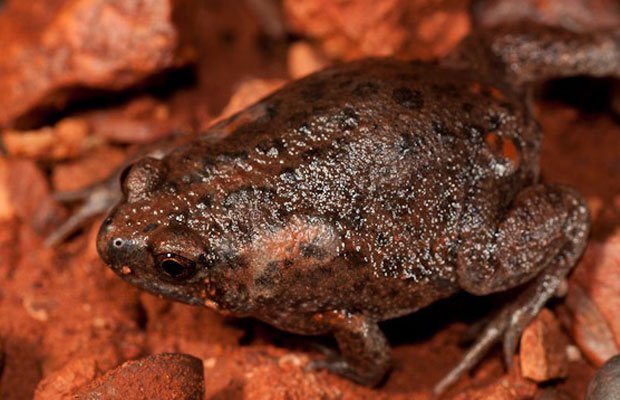Miniature frog discovered in the Pilbara

FOR DECADES, A CRYPTIC and tiny species of frog has remained hidden from scientists in the arid environment of Western Australia’s Pilbara region. But its recent discovery is cause for excitment.
“To find an amphibian in such an inhospitable environment is something special,” says Professor Arthur Georges, herpetologist at the University of Canberra. “The biology of this species no doubt holds many surprises in terms of how it manages to survive and thrive in the Pilbara.”
The Pilbara toadlet (Uperoleia saxatilis) is a 2cm-long burrowing species that eats termites and small insects it finds underground. Toadlets are native to Australia and this new species brings the total number to 27, the second largest group of frog species in the country.
Toad in the hole
The frog was a surprise find for a team of researchers from the Australian National University, Western Australian Museum and the University of Western Australia. Renee Catullo, lead author and PhD student at ANU says the discovery of the brown toadlet was a great bonus in their research efforts.
She says she found the toadlets in rocky gorges and dried-up pools: “They sit in the rocks and find little [natural] amphitheatres so that they can amplify and direct their call to the females.”
“We didn’t expect to find [a toadlet] in the arid zone…the deserts of Australia are often believed to be empty regions with few species. Species have to be quite adapted to survive here,” she says. “Little is known about this small, brown creature but it has been found following cyclonic rains and occurs in rocky gorges and creeks of the region. The good news is that it appears to be secure from a conservation perspective.”
The researchers have used DNA analysis to tease apart different species of frogs that look very similar. Renee’s team built a ‘family tree’, which categorised the DNA sequence in the toadlet group of frogs. They realised that the Pilbara toadlet was in fact a separate species. She says genetic techniques are particularly useful to tell apart species that look identical.
High-pitched calls
“Humans are such visual creatures that when we see two little brown things it’s hard to tell them apart,” she says. “They tell themselves apart by their different calls, but we’re not so good at that.” The Pilbara toadlet’s closest relative is thought to be the mole toadlet (Uperoleia talpa), which is very similar in appearance but has a more intense, high-pitched call.
DNA identification has helped prise out several new species in recent decades. Professor Ross Alford, a herpetologist at James Cook University in Townsville, Queensland, says the discovery of new species of frogs “shows that we really do need to understand our own biodiversity better. On a fine detailed scale, there’s a lot we don’t know.”
These frogs are “very small, cryptic animals that we know very little about, other than that they show up each breeding season,” adds Ross. The remoteness of the Pilbara and the fact it lives underground may explain why the newest toadlet went undiscovered for so long.
The research was published in the June issue of the journal, Zootaxa.
RELATED STORIES

